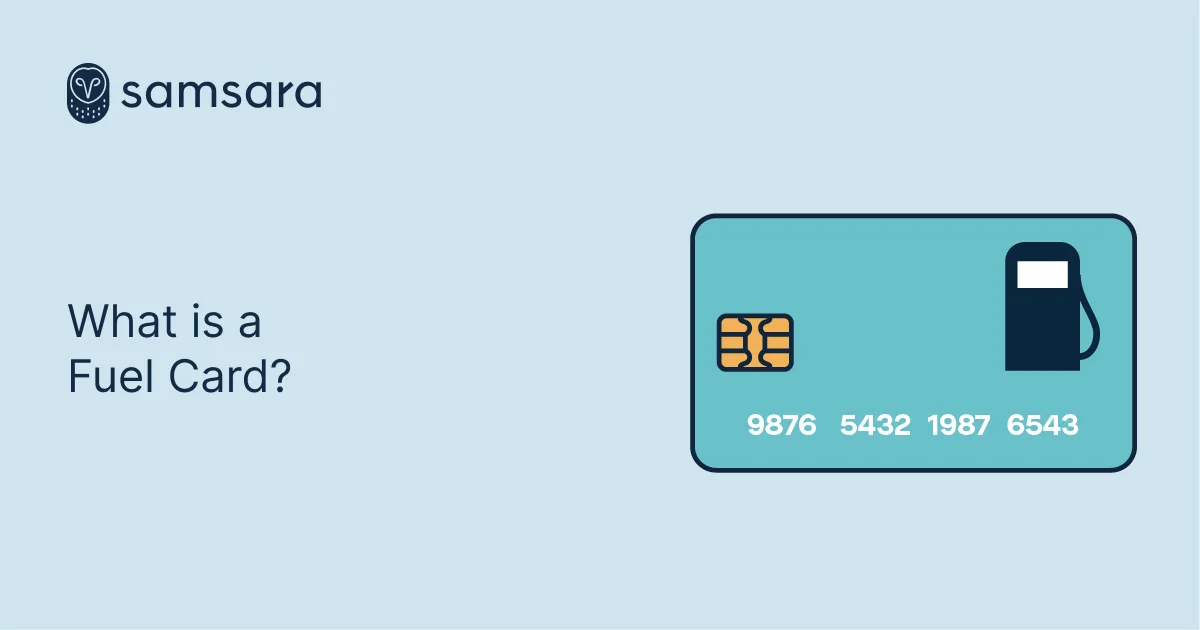What is a Fuel Card?
October 22, 2021

Get Started with Samsara
Check Our PricesKey Takeaways
Fuel cards are a cost-effective, efficient way for fleets to fill up. Similar to (but not the same as) credit cards, organizations can link fuel cards to fleet management systems, allowing for easy tracking and managing of fuel expenses.
What is a fuel card?
A fuel card (or fleet card) is a payment card that allows truckers to purchase gasoline, diesel, and other fuels. In some cases, drivers can use fuel cards for vehicle maintenance and other related expenses.
Fuel cards allow business fleet managers to track fuel purchases in real time, set spending limits, and manage fuel expenses. It also helps fleet managers automate International Fuel Tax Association (IFTA) reporting.
One of the main benefits of using a fuel card is getting fuel discounts. This is because many fuel card programs offer discounted fuel prices or other rebates for purchasing fuel within a network. When companies require drivers to purchase fuel within a network of fueling locations for a discounted price, it helps fleets reduce fuel costs.
Different kinds of fuel cards
There are three different kinds of fuel cards:
Branded fuel cards. These cards are issued directly by fuel companies. ExxonMobil, BP (British Petroleum), and Shell are branded cards.
Universal fuel cards. These cards are not tied to specific fuel providers and can be used at many different locations. Examples include Comdata, Fuelman, and U.S. Bank Voyager.
Merchant branded cards. Fuel merchants partner with fuel companies to offer branded cards. CircleK, Thorntons, and 7-Eleven have fuel card programs.
How does a trucking fuel card work?
Instead of using cash, a debit card, or a credit card to pay at fueling locations, truck drivers and independent owner-operators can use a fuel card to pay for fuel purchases within their fuel card program’s network of partnered gas stations and truck stops.
Typically, the fuel card provider receives a cut from the gas station (usually 2% to 3% of the fuel purchase) for sending their members to the partnered fuel stations. Some providers will offer discounts on the per-gallon fuel prices. These discounts can change regularly based on fuel prices and agreements between the fueling locations and card companies.
When drivers need to refuel, they find a gas station within the fuel card program’s network to fill up. Or, if they have a universal card, they go to any gas station.
Fuel cards work like credit cards; once a driver is at the gas pump, they swipe the fuel card to get started. They may need to enter in a PIN, driver number, or trip number to get started. Or, the driver can go to the fuel cashier’s station, give the attendant the card, tell them how much fuel they want and the identification numbers above.
Previously, the driver would take the receipt and submit it with their other expenses. However, fleet managers can link fuel cards to their telematics systems with today's fleet management software and eliminate the need to keep receipts. Transactions are automatically recorded with all details, including which driver made the purchase, odometer readings, sales tax, and more.
How the fuel card is evolving
The first commercial fuel cards resembled credit cards, but the process to purchase gas was completely manual. When the driver arrived at the filling station, the cashier would jot down the customer’s name and company information to verify ownership of the card. The process was both time-consuming and prone to fraudulent activity.
During the 1980s, as magnetic swipe strips and electronic computing became more commonplace, the fuel card industry expanded. Fuel cards began to use magnetics strip technology, enabling retailers to process transactions electronically, reducing human errors and fraud.
Fuel card technology is changing again. More fleet fuel cards are using smart chips or smartcards, which are more durable than magnetic strips. Fueling limits are also more enforceable through programming the embedded chip. Other fuel card providers are opting to go completely digital. They’re eliminating a physical card and enabling QR codes and NFC (near-field communication) technology via mobile app to handle payments.
Are fuel cards the same as credit cards?
While both fuel cards and company credit cards offer an easy way to pay for fuel, there are a few key differences.
Fuel cards can be assigned to specific drivers or vehicles
While credit cards can be in a company’s name, typically, there also needs to be a person's legal name for security and verification measures. On the other hand, fuel cards can be assigned to specific vehicles, making it easy to view a vehicle’s fuel consumption. Fleet managers can assign drivers fuel card PINs to see which driver filled a vehicle and when.
Fuel cards have more spending controls
Some credit cards offer various forms of spending controls, including setting spending limits or merchant categories. However, carriers can set up very specific spending parameters on fuel cards. For example, fleet managers can have fuel pumps shut off when a purchase limit is reached. Or, they can authorize the purchase of specific products only. So a driver could buy gasoline with a fuel card, but not alcohol or snacks.
Fuel cards have straightforward costs and fees
Typically, fuel card fees are simpler than credit cards, without as many hidden costs. Many fuel cards have an annual or monthly fee structure or a transaction fee structure, which other discounts and rebates can offset. Many gas cards also don’t charge interest fees either.
Fuel cards offer companies fleet-specific discounts
Fuel card programs can offer discounts on fuel based on the amount your company purchases. And similar to airline mileage programs, if carriers stay within a merchant network to purchase fuel, they are eligible for additional cost savings, rebates and discounts.
Fuel cards streamline fleet administration
Because fuel cards are tailored for fleet use, card providers often offer helpful features for fuel management. These include automatic accounting, easy expense reporting, and robust reports that make IFTA record keeping easier.